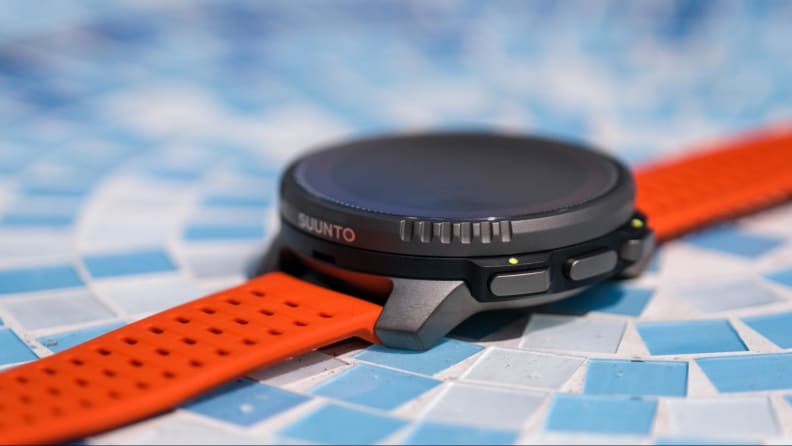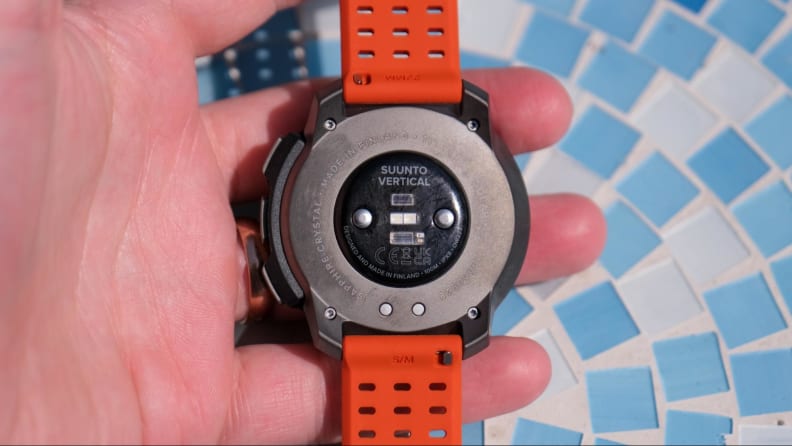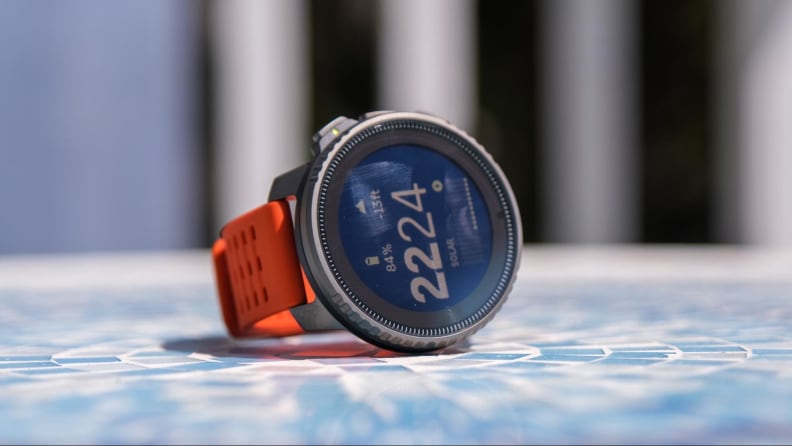The Vertical Titanium Solar is an outdoor sports-focused smartwatch that places, navigation, tracking metrics, and long-lasting battery life before all else. It’s not an inexpensive piece of hardware, even in comparison to wearables with competing features. But it does offer a number of things that traditional smartwatches can’t–starting with a battery life that’s measured in days or weeks, instead of hours.
About the Suunto Vertical Titanium Solar
- Dimensions: 49 × 49 × 13.6mm
- Weight: 74g
- Connectivity: Bluetooth, GPS
- Sensors: Heart rate, barometer, compass
- Water resistance: 100 meters
The Suunto Vertical Titanium Solar is a round-face smartwatch designed for outdoor training and adventures. The Its 1.14-inch matrix display is highly visible in bright sunlight. And, while it is a color display, it’s not going to wow you like an AMOLED or LCD display might. This is a screen meant to convey information in the harshest environments while using the smallest amount of power possible. At night or in darker environments, the watch has a built-in backlight to ensure that you can still see its face and data fields. The Vertical comes in stainless steel and a titanium model that comes with a solar panel array backed into its display. We tested the latter.
What We Like

Credit:
Reviewed / Christian de Looper
We liked the Suunto Vertical Titanium Solar’s clicky buttons and responsive touch display. The watch’s various functions can even be accessed while wearing gloves.
Sleek Design
We really like the design of the Vertical. While chunky, compared to a device like the Pixel Watch, its premium materials and finish, provide it with a sleek, sporty look.
At 13.6mm thick, the Vertical isn’t necessarily the slimmest, smartwatch out there but it is not over-the-top chunky, like the Casio G-Shock GBD-H2000. It’s more subtle in its shape, making it a great choice for those who want a rugged but understated outdoor companion.
On the right side of the Vertical, you’ll find the three buttons that you to navigate the watch’s various functions. The buttons are clicky and easy to press, and they’re well-spaced enough to prevent accidental presses, even when wearing gloves. On the back of the watch, you’ll find the health-tracking sensors.
We found the watch’s interface easy to navigate, using either its aforementioned buttons or tap-and-swipe gestures. You’ll start on the main watch face, and you can then swipe down to access a menu of features, up to access the different workout types, or to the sides to show different screens for things like notifications, weather, heart rate, and more. I found that the watch does a good job of telling you what the buttons do with contextual arrow icons on the display. During testing, I found the watch was occasionally slow to acknowledge input. It was never more than a fraction of a second, but the lag was consistent. That said, this is a minor inconvenience that doesn’t detract from the Veritcal’s overall usefulness.
We liked the selection of straps that Suunto provides to its users. We liked the fact that these 22mm straps are easy to swap out for any other strap of the same size, Suunto branded or not.
Solid Activity Tracking

Credit:
Reviewed / Christian de Looper
During testing, we found that the Vertical Titanium Solar’s health sensors were accurate enough for trustworthy metrics tracking.
The Vertical isn’t just a good-looking device, it’s an excellent fitness tracker. On the back of the device can be found the range of health-tracking sensors, including a heart rate monitor and blood oxygen sensor, gait and other movement sensors, altitude, GPS, and barometer hardware–all of which are important for tracking training progress as an athlete or knowing where you’re going (or have been,) on a hike or cycling trek.
The Vertical comes with dozens of different workout types – so much so that if you’re going to do a new workout, you may find yourself spending a minute or two scrolling through all the options to find the right one. Thankfully, you can re-order the workouts in the Suunto app – where you can also create new modes that show you the data you want to see during a specific workout.
For the most part, I found the device’s metrics to be more or less in line with my Apple Watch Ultra – it tracked my average heart rate over a 1-hour workout as 117 beats per minute, while the Apple Watch tracked at 115. Variations this minute are common.
While your fitness data will sync smoothly to your iPhone or Android smartphone via the free Suunto app, there’s no need to ever look at it, if you’re an iPhone user. The Suunto app with Apple Health. Unfortunately, at the time this review was written, it did not appear to sync with Google Fit.
Offline Maps
One of the biggest advantages to this watch over some alternatives is that it allows the user to store offline maps – which makes it a compelling option for hikers who want something that can be used to stay on track, even when out of cellular coverage. It’s a feature that’s common with outdoor-oriented tool watches, but it’s uncommon to see it in a garden-variety smartwatch.
The Maps, which include topographical data, heatmap information, and more, can be managed and downloaded via the Suunto app, while the Vertical is being charged. Creating waypoints–a must for navigating in the wild, finding your campsite, or making your way to points of interest–are easy to create using the Vertical. That said, the watch and its maps do less well in the city: it can help you navigate a town’s streets to your final destination, but you’ll have to do so without the aid of street names.
Great App Design

Credit:
Reviewed / Christian de Looper
The Suunto App is well-designed and easy to use.
Suunto has put a lot of work into developing the accompanying Suunto app (available on iOS and Android).
The app is well-designed too. From the home screen, you’ll see things like your recent workouts, the amount of time that you’ve worked out, and your progress. You’ll then be able to jump into different tabs to see which days you’ve worked out, data for the workouts, settings for your maps, and your profile. There’s certainly a lot to go through, but I was able to get used to the layout pretty quickly, after which I appreciated how many settings and features were packed into the app.
Long Battery Life
If you’re willing to shell out for the titanium solar model, you’ll get an extra feature – solar charging. This model has a solar panel ring around the watch face, meaning that you may only need to charge the device once per year, or at least every few months.
According to Suunto, the Vertical will get up to 85 hours of continuous exercise tracking with GPS on the solar model, or 60 hours on the non-solar model. With slightly less accurate tracking (Tour mode), you’ll get up to 500 hours of continuous GPS tracking. And, in daily mode, which turns location tracking off, you’ll get up to 60 days with the non-solar model, and up to a massive year with the solar model. That’s very good. It was a little hard to test over a few weeks, but at the end of the testing period, I still had over 90% remaining, which included using the device for fitness-tracking and location-tracked workouts.
What We Don’t Like

Credit:
Reviewed / Christian de Looper
We liked the Suunto Vertical Titanium Solar’s clicky buttons and responsive touch display. The watch’s various functions can even be accessed while wearing gloves.
Premium Pricing
The Suunto Vertical Titanium Solar is a great watch, but it doesn’t come cheap. At the time that this review was written, The least expensive version of the Sunnto Vertical cost $629. If you want the titanium-clad beauty with the solar panels that we tested, you’ll have to fork over $839. That’s a lot of money, for most people. It is, however, in line with other similar devices. The Garmin Fenix 7, for example, costs $650, while the solar-powered iteration will set you back $800. And, of course, the base model is cheaper than the $800 Apple Watch Ultra–a device that offers far more features, but sadly, far less battery life.
While it may lack some of the bells and whistles of the Vertical Titanium Solar, a wearable like the Garmin Instinct 2, which is also available in a solar-powered variant, costs far less and could serve many individuals, just as well.
Not A Traditional Smartwatch
If you’re looking for a piece of wrist-worn tech that’ll let you ditch your phone while you go out for a run, the Vertical is not the watch for you. While you can download offline maps, you can’t download offline music. There’s no tap-to-pay functionality and you can forget about staying in touch with your pals via text over cellular. These aren’t failings of the device’s design. It just wasn’t made for these tasks.
That said, for many, fitness-tracking features and phone notifications such as text messages and caller ID may be all some people want from a smart wearable.
Should you buy the Suunto Vertical Titanium Solar?

Credit:
Reviewed / Christian de Looper
Yes, if you want a stylish hiking watch with offline maps
If you’re looking for an intelligent outdoor watch with incredible battery life, a tough, thoughtful design and tons of features to make your time outdoors or training a safe, metric-filled treat, the Suunto Vertical Titanium is a great option. That it also provides basic smartphone notifications so that you can keep track of your life, on the go, is icing on the cake.
However, if your lifestyle demands a smartwatch that leans into social media, onboard music storage, and the other nice-to-haves that we’ve come to explect from iOS and WearOS-powered devices, you’ll want to look elsewhere.
Meet the tester
Originally from Australia, Christian has long had a passion for gadgets and consumer electronics. Christian has experience reviewing products in all areas of the consumer tech world, and is dedicated to helping people find the best products for their lifestyle.
Checking our work.
Our team is here for one purpose: to help you buy the best stuff and love what you own. Our writers, editors, and lab technicians obsess over the products we cover to make sure you’re confident and satisfied. Have a different opinion about something we recommend? Email us and we’ll compare notes.










